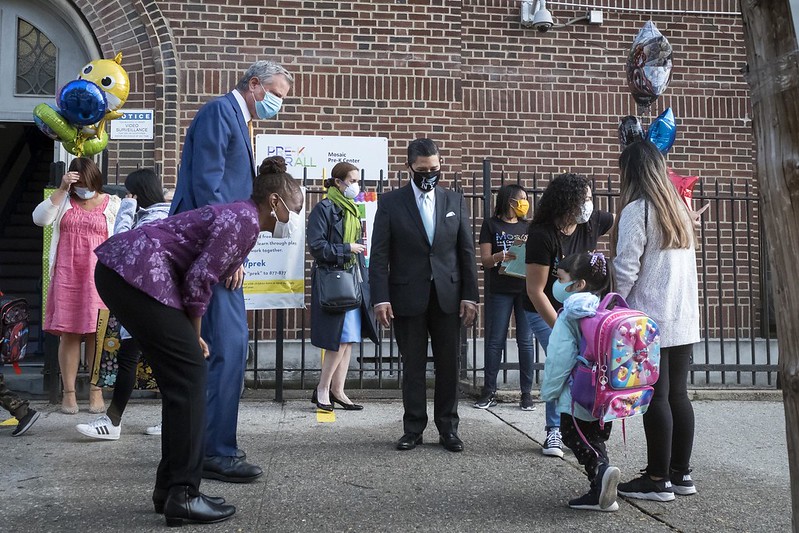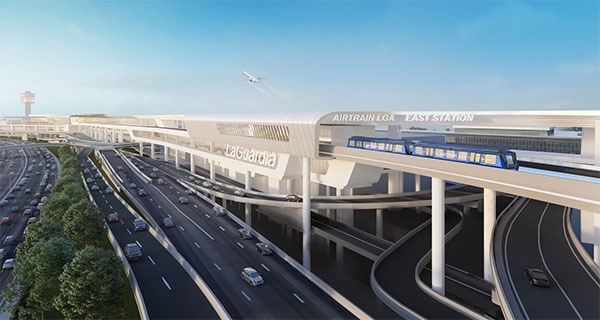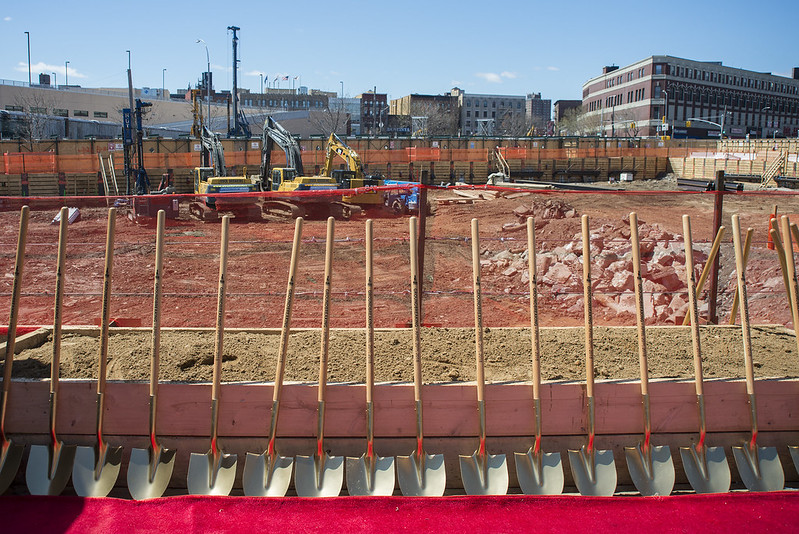4 Steps to Fix the City’s Ongoing School Reopening Failures

Mayor and Chancellor on first day of school (photo: Ed Reed/Mayor's Office)
This city continues to fail us as we attempt to begin the school year safely. Not utilizing any of the months since March to make a safe, equitable reopening plan is unacceptable, and the constant changes to the plan are throwing the lives of many families and educators into complete disarray. It’s time to chart a better path.
Each week brings daily changes as leadership continually pulls the rug out from under students, parents, and educators. Late last Tuesday evening, the night before teachers were set to meet their students online, the mayor announced yet another change to the remote learning policy: students in the hybrid learning model will no longer be guaranteed live remote instruction. Some students will learn from a computer while at school.
The number of teachers and administrators testing positive for COVID-19 has continued to rise, increasing the concern that positive cases only grow as students and teachers come back to school.
Next, just four days before school was to start in-person, the mayor announced another delay, pushing the start of school back to the beginning of October for many students.
As a special education teacher in our public school system and the parent of two young children, as well as a candidate for City Council, I have been speaking out about the inexcusably poor handling of this disjointed reopening planning for months. There is no doubt that the mayor and the Department of Education completely neglected their responsibilities to our students, our educators, and their families.
Throughout the processes of the closure and reopening of schools, shortsighted planning has been incredibly harmful and led to confusion and stress for our educators and families. Educators need to plan how we will meet the social-emotional, mental health, and academic needs of our children, while families want the best for our children and need to be able to plan for our own work schedules. This lack of planning has been an all-too-frequent hallmark of the current administration, which has let down students, educators, and most New Yorkers on schools and much more.
Instead of treating every student as if they have the same needs, our City needs to reimagine how we’re approaching school reopening, just as we need to reimagine every aspect of our city’s recovery to ensure it is both deliberate and just. Here are four key steps:
Clarify safety standards. According to the Department of Education’s website, a classroom can be cleared by having “at least one functioning method of ventilation,” which could be “a window that opens, a type of mechanical ventilation (exhaust fan, supply fan, unit ventilator) or a combination of the both.” However, even Donald Trump’s EPA notes that “Even with an open window or door, natural ventilation can be limited if inside and outside temperatures are similar and there is little wind.” We must have rigorous and transparent standards regarding our safety if we are to build confidence and trust in a school’s ability to host in-person learning.
Recognize the dual roles of schools as places of learning for our next generation and of child care so parents can go to work, while understanding that different students and families have different needs. We should prioritize in-person learning for students with disabilities, young students, English language learners, students from high-need homes (homeless, food insecure, etc.), and students from families with other major needs, allowing them to have as many days and hours of in-person learning as possible.
With that in mind, older students who are more self-sufficient and independent -- mainly high school students, with exceptions for high-needs students and families -- should have all-remote learning, with the opportunity to participate in counseling and extracurriculars as needed. After all, a 5-year-old with a disability has a greater need for more robust in-person learning than a 16-year-old student. Their educational and emotional needs are not the same, and a family’s child-care needs are not the same with regard to different age groups.
I agree with the latest decision by the city to phase in in-person learning beginning with the students that need it most, but it is insulting that they announced the change days before school was to start in-person for everyone participating in blended learning. Even with this, there would still be many families who want their children to learn remotely, which would be feasible as there will still be teachers who will teach remotely.
Be resourceful in maximizing our space, especially as the weather changes. While there are many avenues to utilize outdoor spaces like recess yards, NYC Parks, and closed off streets, this is only viable until it becomes unsafe to spend extended periods of time outside. If fewer high school students are in attendance, those buildings can be put to use for younger students or students with additional needs. If we want to further consolidate the number of school buildings in use, we can also be flexible with scheduling for older students, which is made easier by the fact that many high schools’ in-person models do not have students in attendance for a full school day anyway.
Provide more consistent guidance and recognize the hardship parents, students, and teachers are dealing with as we adjust schedules and teaching plans last minute. The mayor and his administration have continually disrespected parents, students, and teachers with plans changing at the last minute. Once we begin in-person learning, deadlines must be given and held. Teachers and parents deserve to know the benchmarks and timelines for ensuring school is safe and meeting the needs of all students.
For weeks, students, parents, and educators have been sounding the alarm about the city’s preparedness for school, and it is incredibly frustrating that the city’s leadership continues to fail us. Parents made decisions based on promises from the city, and the city’s inability to plan adequately reflects the incompetence of the planning and implementation of a coherent plan.
We can’t have a functioning city without consistent guidance and residents trusting city leadership. We need leaders who listen to New Yorkers and who can reimagine the way we educate our children -- and we deserve better, more creative approaches for those who feel forgotten by the bureaucracies at the Department of Education and City Hall.
***
Eric Dinowitz is a special education teacher and a candidate for City Council in the 11th District in the Bronx. On Twitter @EricDinowitz.
***
Have an op-ed idea or submission for Gotham Gazette? Email This email address is being protected from spambots. You need JavaScript enabled to view it.
AirTrain LaGuardia is Economic Stimulus New York Needs to Turn The Corner

Rendering of the Airtrain LaGuardia (photo: A Better Way to LGA )
When it comes to rebuilding an economy mired in crisis, my brothers and sisters in the Building and Construction Trade unions have been on the front lines time and time again. We know that building back our economy always begins with building up our infrastructure better than before. And today is no different.
AirTrain LaGuardia is a perfect example of an infrastructure project that can lead the way in putting New York City back on its feet. Construction of AirTrain will get 3,000 skilled union members back to work in good-paying jobs at a time when those jobs – and the additional economic activity they will create – are sorely needed.
Members of the building and construction trades suffered greatly during the pandemic. At one point during the spring, 975,000 construction workers around the nation were unemployed as job sites shut down due to the deadly threat of COVID-19.
Yet at projects deemed essential here in New York, including the building of a new LaGuardia Airport, our union workers continued to show up every day. We worked with our partners to make the job site as safe as possible, and we kept the project moving forward on time, as you saw with the opening of a new Terminal B in June.
Thousands of construction workers at LaGuardia earn a paycheck, support their families, pay their mortgages, and patronize local businesses around the airport. Infrastructure projects like AirTrain LaGuardia will continue that opportunity, not only supporting our construction workers, but supporting entire communities.
That’s why we at Laborers’ Union Local No. 731 strongly support AirTrain LaGuardia, which will create the kinds of jobs we need most – jobs that are a pathway to the middle class. And thanks to expansive apprenticeship programs offered by the Building and Construction Trades Council of New York, as well as our local, these are jobs that are increasingly filled by people of color, women, and military veterans from right here in the five boroughs.
AirTrain LaGuardia, like the transformation of LaGuardia Airport, will also create new opportunities for Minority- and Women-Led Business Enterprises and local businesses based in Queens. More than $1.4 billion in contracts were awarded to MWBE firms for work at LaGuardia Airport. Roughly $500 million in contracts went to Queens-based companies. AirTrain will continue that policy of equity.
LaGuardia Airport is the only major airport on the East Coast without a rail mass-transit link. That was unacceptable in years past and it is even more unacceptable going forward as our workers build the nation’s most technologically sophisticated, efficient, and beautiful airport in the country.
AirTrain would create a dependable ride from the airport to Midtown Manhattan, taking less than 30 minutes with a connection at Willets Point to either the LIRR or the No. 7 subway. Based on surveys of passengers at LaGuardia, as many as 10 million travelers a year would use AirTrain, removing millions of vehicles annually from congested highways and local streets.
Unlike the other alternatives, some of which have been debated for decades, AirTrain LaGuardia would take no private property and would not run through any residential neighborhood or commercial districts. It would be separated from the nearest homes by the eight-lane Grand Central Parkway.
This is a project that can get done. The Port Authority and our union workers have a track record of completing major infrastructure, including AirTrain JFK, a project that I am proud to have worked on for four years as a shop steward. Our skilled union workers built AirTrain JFK, which has been successful far beyond expectations, outpacing paid ridership projections by 55 percent and serving as a catalyst for more than $1 billion in private and public investment in downtown Jamaica.
A new AirTrain LaGuardia connecting to expanded LIRR and subway service could play the same role by jumpstarting the redevelopment of a blighted, industrial site at Willets Point into a new neighborhood with mixed-income housing, shops, hotels, a new school and new parks astride some of the city’s great attractions, creating even more jobs for our building and construction trades and opportunity for all New Yorkers.
We can no longer afford to waver and delay before moving forward. Waiting is not an option during an economic crisis. Now is the time to invest in a 21st century infrastructure for a 21st century post-covid economy by moving forward with AirTrain LaGuardia. The skilled men and women of our New York’s Building and Construction Trades Council, including Laborers Local 731, stand ready.
***
Carmine D’Amato is the Assistant Business Manager for Laborers’ Union Local No. 731
***
Have an op-ed idea or submission for Gotham Gazette? Email This email address is being protected from spambots. You need JavaScript enabled to view it.
Economic Development in a Pandemic: Let's Launch The Bronx Reconstruction Program

A ground-breaking in the Bronx (photo: Jeff Reed/City Council)
Recent events have made it abundantly clear that the Bronx needs new, creative solutions. To rebound and rebuild stronger from the crises we face, we need policies that bring equity to economic opportunity; sustainable, liveable neighborhoods with great local schools; resilient communities; affordable, accessible transportation; and local input from the community about decisions affecting the community.
In that spirit and as part of my candidacy for New York City Council in the Bronx’s District 11, I am proposing that the Bronx become a pilot for a job-creation program modeled on, but more equitable than, the Civilian Conservation Corps started by President Franklin Delano Roosevelt during the Great Depression.
The Bronx Pandemic Reconstruction Program would include free training and education so that all Bronxites are equipped with the skills for adapting and thriving in the 21st century. The program would focus on communities of color and the communities most severely impacted by the pandemic-spurred economic collapse.
Employment
The Bronx Pandemic Reconstruction Program would create 10,000 jobs by offering unprecedented training opportunities across five tracks. Free, degree-pathway classes at area CUNY and SUNY schools will prepare program participants to undertake key roles:
Green technology jobs that will help us transition away from fossil fuels and improve local resilience, like building retrofits and renewable-energy projects for local solar and geothermal power.
Infrastructure rebuilding jobs to repair our crumbling schools, roads, and community spaces.
Entrepreneurship and incubation to create nonprofit organizations and socially responsible businesses focused on the arts, environment (composting and community gardens), transit and micro-transit, public safety, independent bookstores, high-tech, urban agriculture, food production and distribution.
Elder Care jobs to eliminate isolation and provide transportation, age-appropriate programming, and health-related supervision.
Child Care jobs to ensure that parents can work and young adults can become mentors (more below).
Child Care
After months of lockdown, remote work, and online education, many parents know that they can manage either their jobs or their kids, but not both at the same time. Meanwhile, teenage and young-adult unemployment in the Bronx has skyrocketed as jobs in retail shops, bars, and restaurants have disappeared. As part of the Bronx Pandemic Reconstruction Program, parents across the Bronx could join with others to form their children into “pods,” small groups of 6 to 10 children, who can be cared for by teenagers and young adults employed by the BPRP as tutors, counselors (for hours when children are not in school due to split shifts and staggered days, or after-school hours), and coaches.
With commercial space more widely available as businesses have shut down, these pods can be out of the house but competently supervised by their BPRP minders in neighborhood outdoor and indoor locations, arranged by the BPRP.
Financing the Bronx Pandemic Reconstruction Program
The infrastructure track of the Bronx Reconstruction Program easily can be underwritten by existing New York City capital funds. In the case of grants for social and for-profit entrepreneurs as well as subsidizing green-tech jobs, we can seek public-private partnerships with the city’s biggest banks and corporations, which must step up as they did during New York City’s financial crisis of the 1970s. For elder and child care, we can mine the large pockets of waste that exist in the New York City budget for job creation.
These ideas may seem daring, but the city is facing an unprecedented crisis requiring innovative solutions. We are confronted by a public health crisis, structural racism, and
poor financial planning locally and nationally. To surmount them, we must face them head-on as a unified community in order to protect our families and our neighborhoods, as well as the greater borough and city we call home.
***
Jessica Haller is a candidate for City Council in the 11th District in the Bronx. On Twitter @JessicaHaller.
***
Have an op-ed idea or submission for Gotham Gazette? Email This email address is being protected from spambots. You need JavaScript enabled to view it.




